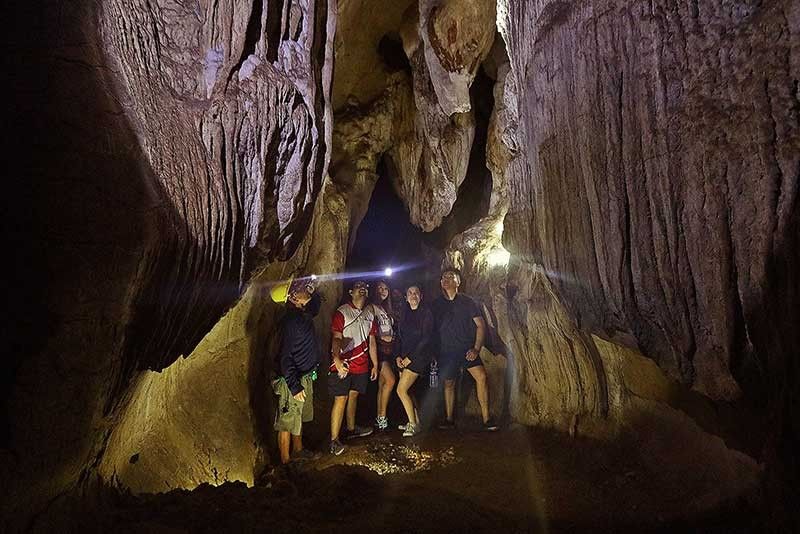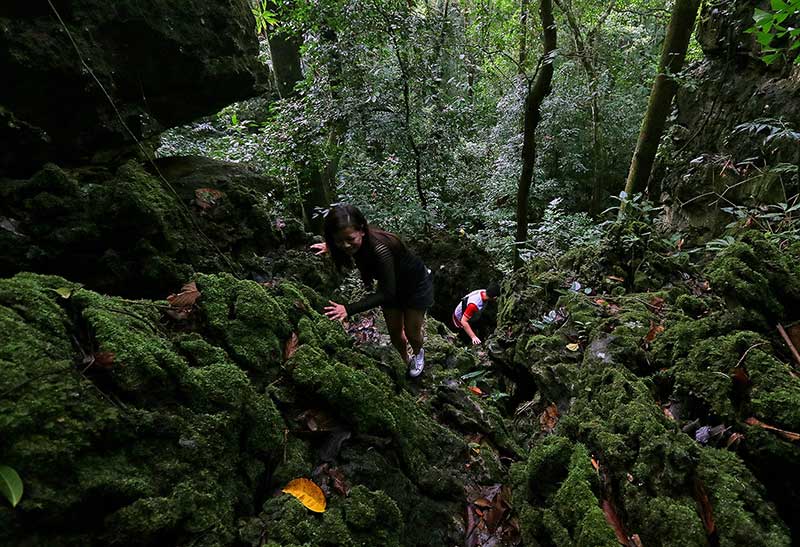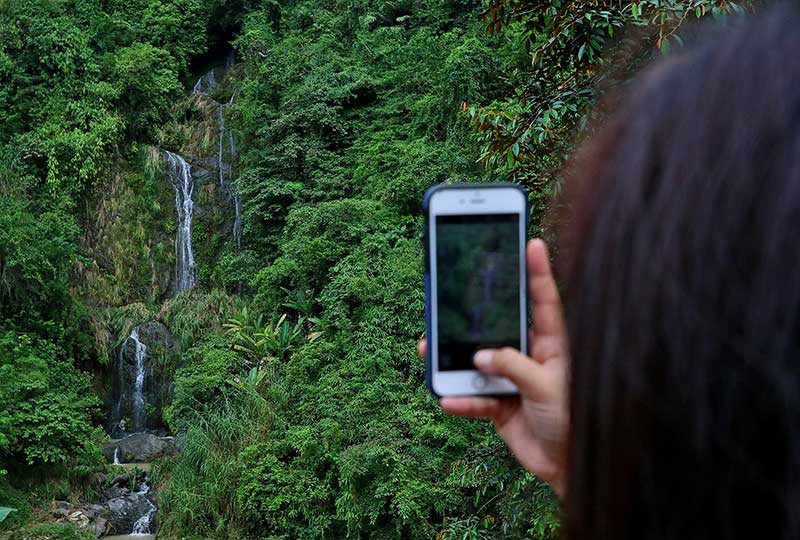TRAVEL CEBU: Minglanilla, where fun can begin

“The fun begins here!”
This is the battle cry of Minglanilla as the southern town, located 15 kilometers from Cebu City, starts a revolution – an ambitious and passionate tourism revolution.
Minglanilla is known, especially to Cebuanos, of its elaborate staging of the Sugat Kabanhawan Festival on Easter Sunday, a reenactment of Jesus Christ’s resurrection.
The Tourism Revolution Project is, of sorts, a resurrection of an initiative that took a backseat when the town’s tourism officer, Miss K Alicaya, took a break from government work several years ago. Now back in the frontlines, she aims to finish what she started.
Alicaya tells the Travel Cebu team that Mayor Elanito Peña wants the project in place in the next three years and P1 million has been earmarked to kick-start it.
The revolution begins in Barangay Campo 7 nestled at the foot of an imposing mountain that is home to Minglanilla’s less discovered wonders: Lush, undisturbed forest; clean, cool air; peace and quiet disrupted only by the chirping of birds; and its crowning glory: Seven caves that can satisfy any spelunker’s heart.
Breathing life to the mountain are 75 species of flora with 36 kinds of trees; 30 species of birds, amphibians, mammals and reptiles; and 32 species of insects and spiders.
The town’s information officer, Eric Pagar, says the Tourism Revolution Project includes development of the seven caves, man-made forest, and farm tourism but the caves are the first items on the agenda.
The trek to the caves begins at the barangay hall of Campo 7. Up front, we recommend coordinating with the barangay’s officials for safety and security. Because a trail going up and down the mountain is yet to be established, an unassisted climb can be dangerous to inexperienced climbers, especially when it rains and the steep, sharp rocks become wet and slippery. One misstep may lead one plummeting down a steep ravine.

The ascent is strenuous and proves the saying that one should never underestimate a mountain. We recommend preparing physically before climbing. For the most part, it’s a 50-degre climb, sometimes 75, and you won’t have a choice but hoist yourself up or climb down rocks, and walk through vegetation. Stretching exercises and jogging days before can help prevent injuries and develop stamina.
If you want to avoid cuts, scratches, or bruises, proper hiking or trekking attire is recommended. Appropriate trekking shoes can help you navigate through rugged terrain.
While we recommend water and snacks, heavy bags are discouraged as they can weigh you down easily. Big bags will also make squeezing through small openings at the caves a lot difficult.
Flashlights, protective head gear, and even ropes will be most helpful when exploring the caves. While the barangay can provide guides, it cannot provide the equipment you need, especially if you visit in big groups, at least for now.
You must also be prepared to spend long hours in the mountain. The barangay captain of Campo 7, Catalino Largo, tells us a visit to all seven caves, including the trek up and down the mountain, would require starting the climb very early in the morning and descending late in the afternoon. The distance from the first cave to the seventh is easily three kilometers, he says.
PLANS
Alicaya says the first order of business, as far as developing the mountain is concerned, is establishing a “safety trail.” This means a clear path up and down the mountain, from one cave to another; ropes that climbers can hold on to; and signs that point the way.
A team that assessed the mountain in April this year recommended that the town also set up safety cable lines, cable access (stairs and ladders in ledges), and nylon webs for climbing. It was also recommended that a one-entry and one-exit strategy be established to control the number of people that go up the mountain. Other recommendations include a canopy walk, rope course, bridges, and even a zipline.
Considering that development efforts are back to the drawing board, Alicaya explains that the Department of Environment and Natural Resources (DENR) will have to reassess the mountain and the caves to ensure their safety and stability. The last time DENR checked the area was in 2014 and the agency looked into what flora and fauna are present, stability of the ground, and conditions of the stalactites and stalagmites in the caves.
If assessment by DENR is positive, the Department of Tourism (DOT) will step in for another level of assessment. The good news, Alicaya says, is that DOT may provide financial incentive if it sees that the area is ripe for development. DOT can also provide trainings and even accredit tour guides.
Alicaya says these will be beneficial to Minglanilla’s efforts to establish itself as a tourism destination but, more so, to the residents of Campo 7 who will benefit from a new source of livelihood.
Beyond tourism, Alicaya says the revolution must also be a movement to preserve and protect the environment. The April 2019 assessment found vandalism on the walls of Caves 3 and 5; harvesting of birds’ nests and phosphate at Cave 7, and treasure diggings at several of the caves.

AVIARY
Down from the mountain, Minglanilla also wants to establish an aviary at the man-made forest also located in Barangay Campo 7.
At least 123.4 hectares of the forest is being managed by the Coastal Resources and Ecotourism, Research, Development, and Extension Center (CRERDEC) of DENR.
Anselmo Aurestila, Science Research Specialist at CRERDEC, tells Travel Cebu that the 123.4 hectares is part of the Osmeña Reforestation Project, which began in 1916. The project was suspended during World War II but was continued eventually until the area was planted fully in the 1960s.
Today, the man-made forest hosts trees that are endemic and indigenous to the Philippines, as well as exotic species. Among the endemic and indigenous species are Narra, Almaciga, Tanguile, Bagtikan, and Banaba while the exotic department features Mahogany, Lumbang, Teak, and Norfolk Island Pine.
Alicaya says the town would want to bring in birds that can survive the present environment at the man-made forest, something that will have to be assessed by DENR.
HOPEFUL
Alicaya admits that the Tourism Revolution Project is an ambitious one but one that is well within reach with hard work and sustained determination.
What is essential, she says, is for the project to have continued support from the local government unit, as well as the officials of Barangay Campo 7.
With the rate things are going, it seems like it will only be a matter of time before Minglanilla can say finally, and without hesitation, “the fun begins here!”/JMO
FAST FACTS:
- Minglanilla is accessible from Cebu City via private and public transport (taxi or bus). Travel is around 30 to 40 minutes, depending on traffic.
- Barangay Campo 7 can be reached via private and public transport but the most accessible public transport at present are motorcycles known locally as habal-habal. Travel is around 30 minutes from the town proper.
- For inquiries, Barangay Campo 7 can be reached via 09474713061
- Latest





























